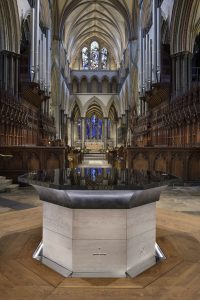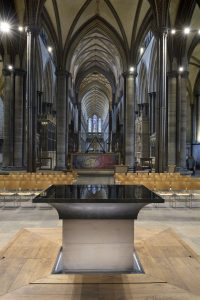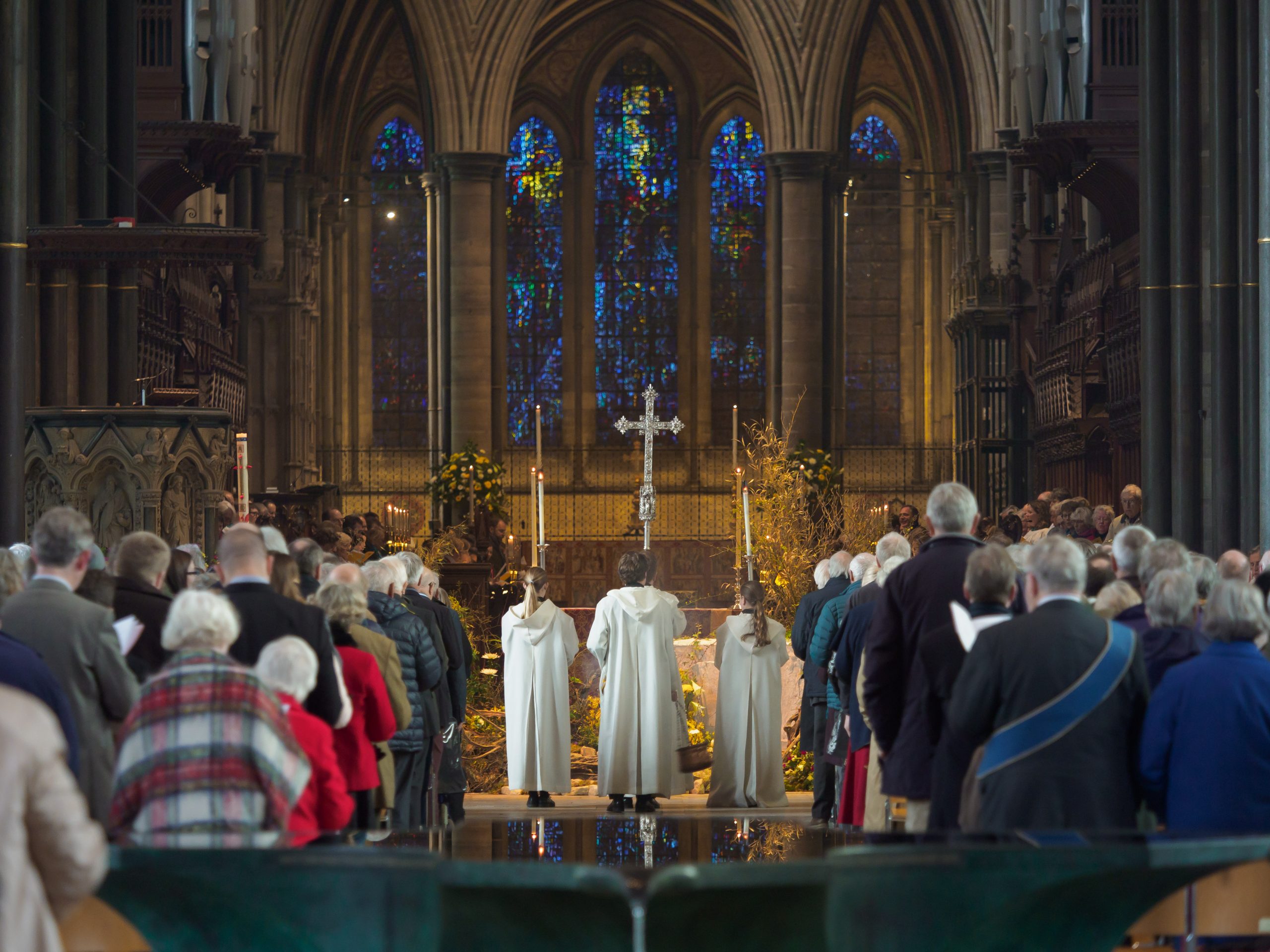Salisbury Cathedral formally unveils two new altars created by sculptor William Pye
On Sunday 14 January 2024, after more than 10 years of planning, selecting and commissioning designs, Salisbury Cathedral formally unveiled two new altars, which were consecrated by the Right Revd Stephen Lake, Bishop of Salisbury, during the 10.30 Eucharist.
This is the first time in 500 years that a new altar has been consecrated in the Cathedral Nave and at least 20 years since the decision was taken to re-order the Cathedral.
The altars are a unique collaboration between sculptor William Pye and furniture maker Luke Hughes, a former Cathedral school pupil, and will be placed in the Spire Crossing and Trinity Chapel respectively.
The commissioning process began in response to a Liturgical Plan drafted in 2014 and updated in 2016. Design competition entries were invited in August 2018 and presentations made to The Very Revd Nicholas Papadopulos, Dean of Salisbury and the Cathedral Chapter (or governing body) in December of that year.
Luke Hughes, who won the design competition, agreed with the Dean and Chapter that the new altars should be linked in form and material to the William Pye font, installed in 2008, making good use of the Cathedral’s magnificent end-to-end vista, and from this proposition grew the artistic collaboration that resulted in these two exceptional pieces.
William Pye and Luke Hughes met for the first time in February 2020 and agreed a division of labour. Pye was to concentrate on the detail design of the altars, while Hughes took on the task of space-planning and designing the daises. Hughes also took responsibility for the clergy seating, movable choir music desks and supporting furniture for the Trinity chapel. Some of this additional work has yet to be commissioned.
Sculptor William Pye, who designed and made the altars said:
“The collaboration with Luke has been a very fruitful one – and his instinct to mirror the materials, architecture and magnificence of the space is very much in line with my own thinking, particularly in relation to the original font – but I also wanted the altars to feel intimate, using the words and symbols that have been inscribed around the base to capture the inner, individual experience of faith as well as the shared experience. The lettering that form the texts and the way they are deployed aim to arrive at something akin to a Roman tablet, avoiding the suggestion of contemporary design or gothic pastiche. The icons that accompany the texts all make reference to features that can be seen within the Cathedral.
“It is deliberate that the altars strongly echo the vernacular of the font and the Cathedral architecture. I wanted the altars to belong to the space, whilst making a statement. And just as the font has become part of the visitor experience and worship, I hope these two new altars will also form part of that experience.”
Furniture maker Luke Hughes, who was responsible for planning the space and building the daises for the altars, said:
“My passion lies in creating and crafting ‘furniture’ that enhances ancient spaces like Salisbury Cathedral. In this case I not only had to respond to the building, but also to William Pye’s design. And there were practical considerations too. The platforms had to be easy for the vergers to dismantle and move, and sturdy enough to withstand being regularly taken apart and reassembled. So, the challenge was practical as well as aesthetic.”
Hughes’ daises, made in oak and shaped to mirror each altar, have been designed and constructed in such a way that what looks like a solid structure is in fact made up of a series of interlocking parts that sit on wheels. The elegance of the design is breathtakingly simple and like the Cathedral itself, a feat of engineering as well as being beautiful to look at.
Celebrating the official installation of the new altars, The Very Revd Nicholas Papadopulos, Dean of Salisbury said:
“We are delighted with the work of these two exceptional artists and craftsmen, which so beautifully and simply complements the aesthetic and design of the Cathedral. By mirroring the shape and materials used in the font – Purbeck stone and inscribed bronze – William Pye has created a sense of permanence and simplicity. And just as the font’s still water reflects the Cathedral’s vaulting and the stained-glass windows, the darkened glass surface on each altar also echoes both vaulting above and stained glass, so that this lofty space and the altars become one.”
The Revd Anna Macham, Canon Precentor of Salisbury Cathedral with responsibility for liturgy and music, said:
“For a long time we have made good with various arrangements of carpeted staging blocks and temporary altars, so to see the new altars in place is inspiring. In both cases the space in which each new altar stands is significant. The Trinity Chapel is where prayer is offered every morning of the year, and the Spire Crossing is where the principal Sunday services and great seasonal liturgies are celebrated. The aesthetic link between the font and the altars is powerful too, tracing the Christian journey that begins at the font through to the quiet, reflective chapel at the East end of the Cathedral.


The two altars, photographs by Douglas Atfield
Details of each altar
The Spire Crossing altar is octagonal, as is the space it occupies beneath the Cathedral’s Tower and Spire and the oak dais around it. The stone base is inscribed with a text from St Matthew’s Gospel:
“Come to me, all you that are weary and are carrying heavy burdens, and I will give you rest. Take my yoke upon you, and learn from me; for I am gentle and humble in heart, and you will find rest for your souls.” (St Matthew’s Gospel 11: 28-30)
These words (spoken by Jesus) express the welcome that the Cathedral seeks to offer to all. In addition to the inscription, William Pye has also carved images, or icons, drawn from the Cathedral’s architecture into the stone, such as the Sudan candle and Foramina shrine.
The bronze section of the Spire Crossing altar is also inscribed with the eight so-called ‘O’ Antiphons, or chants, which are sung at Evensong on eight evenings before Christmas. These antiphons also feature in the Cathedral’s magnificent From Darkness To Light service. The first seven are Biblical titles ascribed to Jesus – and the eighth, unique to Salisbury, addresses his mother, Mary.
The altar in the Trinity Chapel also carries an inscription – lines from The Altar by George Herbert, one of England’s greatest poets, who worshipped in the Cathedral and whose statue stands in a niche on the West Front.
The new altar project has been made possible thanks to the support of the Friends of Salisbury Cathedral, a substantial anonymous legacy, and resources set aside by Cathedral Chapter for this very special purpose.




